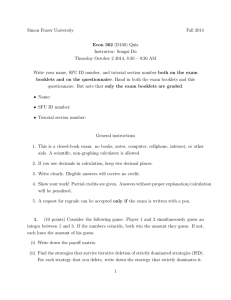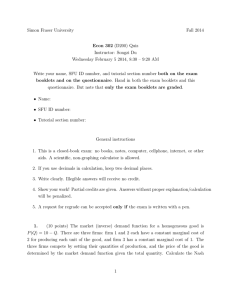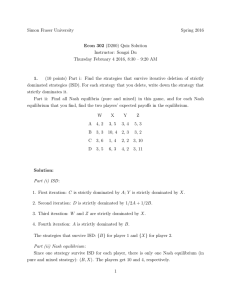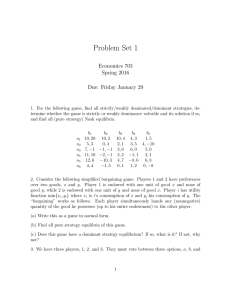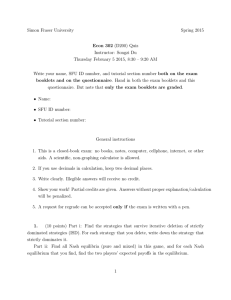Simon Fraser University Spring 2016 Econ 302 (D200) Quiz Instructor: Songzi Du
advertisement
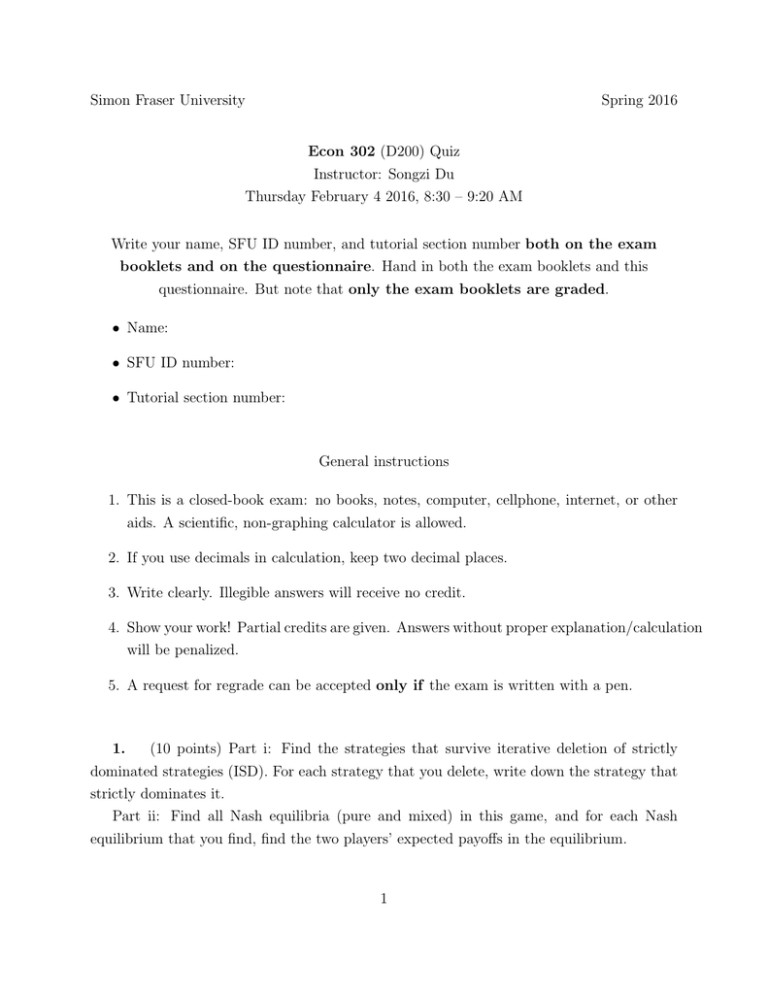
Simon Fraser University Spring 2016 Econ 302 (D200) Quiz Instructor: Songzi Du Thursday February 4 2016, 8:30 – 9:20 AM Write your name, SFU ID number, and tutorial section number both on the exam booklets and on the questionnaire. Hand in both the exam booklets and this questionnaire. But note that only the exam booklets are graded. • Name: • SFU ID number: • Tutorial section number: General instructions 1. This is a closed-book exam: no books, notes, computer, cellphone, internet, or other aids. A scientific, non-graphing calculator is allowed. 2. If you use decimals in calculation, keep two decimal places. 3. Write clearly. Illegible answers will receive no credit. 4. Show your work! Partial credits are given. Answers without proper explanation/calculation will be penalized. 5. A request for regrade can be accepted only if the exam is written with a pen. 1. (10 points) Part i: Find the strategies that survive iterative deletion of strictly dominated strategies (ISD). For each strategy that you delete, write down the strategy that strictly dominates it. Part ii: Find all Nash equilibria (pure and mixed) in this game, and for each Nash equilibrium that you find, find the two players’ expected payoffs in the equilibrium. 1 W X Y Z A 4, 2 3, 5 3, 4 5, 3 B 3, 3 10, 4 2, 3 3, 2 C 3, 6 1, 4 2, 2 3, 10 D 3, 5 6, 3 4, 2 3, 11 2. (10 points) The market demand function for a homogeneous good is Q(P ) = 50−P/2. There are two firms producing this good: firm 1 has a total cost of C1 (q1 ) = q12 ; and firm 2 has a total cost of C2 (q2 ) = 4q2 , where q1 and q2 are the quantity of production for firm 1 and 2, respectively. Suppose that the two firms compete by simultaneously setting their quantities (q1 and q2 ), and the price of the good is determined by the market demand function given the total quantity. Calculate the Nash equilibrium (q1 , q2 ) in this game, and calculate the price in this equilibrium. 3. (10 points) You and a friend are in an Italian restaurant, and the owner offers both of you a free eight-slice pizza under the following condition. Each of you must simultaneously announce how many slices you would like; that is, each player i, (i = 1, 2) announces his/her desired amount of pizza, 0 ≤ si ≤ 8 (si has to be an integer). If s1 + s2 ≤ 8 then the players get their demands (and the owner eats any leftover slices). If s1 + s2 > 8, then the players get nothing. Suppose a player’s payoff is the number of slices that he/she gets. For example, if s1 = 3 and s2 = 4, then player 1 gets 3 and player 2 gets 4; if s1 = 3 and s2 = 6, then each player gets 0. (i) Find all pure-strategy Nash equilibrium (s1 , s2 ) in this game. (ii) Is the following a mixed-strategy Nash equilibrium: player 1 announces s1 = 4 with probability 1/2 and announces s1 = 5 with probability 1/2, and player 2 announces s2 = 4 with probability 1/2 and announces s2 = 3 with probability 1/2? Why or why not? 2



